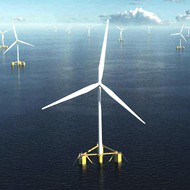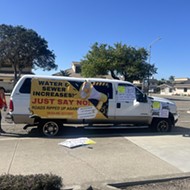Offshore energy: A state task force is in the preliminary stages of creating a wind farm off the Central Coast
By Karen Garcia[
{
"name": "Promo Temp Targeted",
"id": "PromoTempTargeted",
"class": "inlineCenter",
"insertPoint": "4",
"component": "15511697",
"requiredCountToDisplay": "0"
},
{
"name": "Ad - Medium Rectangle CC01 - 300x250 - Inline Content",
"class": "inlineCenter",
"insertPoint": "8",
"component": "15582119",
"requiredCountToDisplay": "12"
},{
"name": "Ad - Medium Rectangle LC01 - 300x250 - Inline Content",
"class": "inlineCenter",
"insertPoint": "18",
"component": "15582122",
"requiredCountToDisplay": "22"
},{
"name": "Ad - Medium Rectangle 9 - 300x250 - Inline Content",
"class": "inlineCenter",
"insertPoint": "28",
"component": "15582121",
"requiredCountToDisplay": "32"
}]
Off the coast of Morro Bay, you may be able to one day see (far out in the distance) the blades of wind turbines moving in the breeze. At least that’s what a state task force is working to accomplish, so it might be a few years.
Trident Winds—a developer interested in creating a wind farm off the Central Coast—kicked the pilot project into gear in 2015 when it submitted a lease request for the ocean floor. The project is still in its infancy, but Alla Weinstein, founder of the company, said offshore wind would add to the mix of renewable energy that California demands.
“It will provide a much stronger source of energy with more consistency and more hours of energy flow in the day than other resources,” Weinstein said.
On April 13, a state task force held a public meeting in the SLO County Board of Supervisors chamber to discuss the blueprints for the proposed wind farm near Morro Bay. While the team had answers about the process of getting this project in the water, it couldn’t engage in conversations about the impact those turbines could have on coastal resources.
The task force consists of members from the California Energy Commission and the Bureau of Ocean Energy Management and was put together to look into offshore wind as another potential source of renewable energy.
In 2002, the state created a Renewables Portfolio Standard Program with the goal of increasing the percentage of renewable energy used by Californians and decreasing the greenhouse gases generated. The current goal is a 33 percent reduction in greenhouse gas emissions by 2020 and 50 percent by 2030. Offshore wind energy is the latest renewable resource to enter the portfolio.
California Energy Commissioner Karen Douglas said offshore wind wasn’t previously considered because of its high cost. Wind farms have started to pop up on the East Coast—the first being offshore from Rhode Island—but the majority sit off the coast of Europe.
Waters off the East Coast and Europe are shallow, so the turbines are held by stationary infrastructure bound to the ocean floor, Douglas said. As this type of renewable energy gains momentum, these products are becoming mass-produced and cost is going down.
“So a resource that seemed even a few years ago to be a lot more expensive, than a lot of alternatives that we already have here in California, suddenly seems much closer to being a potential in our market,” Douglas said.
The water off the West Coast is deep and it wouldn’t be feasible to affix turbines to the ocean floor, so the project proposed for the Central Coast would be a little different than what’s happening in the Atlantic Ocean, Weinstein said.
She said research and designs for floating turbines are currently underway for something that could not only accommodate California’s ocean floor situation, but would also be something that could be easier to move.
“We’re going to be using floating foundations, and those are moored to the ocean floor, and for them to be removed, it would be a simpler procedure because you would literally yank at the anchors and pull them out,” she said.
The company favors the Central Coast because of its existing energy plants—Morro Bay Power Plant (decommissioned in February 2014) and Diablo Canyon Nuclear Power Plant (expected to be decommissioned by 2025)—that could easily connect the potential wind farm to the grid.
While the project would be adding to the overall goal of increasing renewable energy in the state, Weinstein said the turbines could also bring in local jobs.
“I can’t really talk to them in quantification because the work has not been done, but if you look at Europe, do some extrapolations,” she said. “The mere fact that the offshore wind industry does not exist, you will be effectively creating a new industry.”
Even though this kind of energy could have positive impacts, the state task force is reaching out to the public to learn about the impacts it could have on wildlife and the local fisherman.
“The objective we have is coexistence and we coexist together. We’re not doing anything that needs to be done such that people don’t feel that we’re just coming in and don’t care about them, because we do,” Weinstein said.
That was the goal of the public meeting on April 13—to reach out to the community and to learn what impacts the task force should be researching. Only a few attendees spoke during the comment period, but their main concerns were for marine life and whether turbines would obstruct their view of the ocean.
Morro Bay Mayor Jamie Irons is excited about the potential project because of his previous experience working in the now retired Morro Bay Power Plant.
“I’ve been in the energy field so I probably have a different perspective and interest in that; it’s fascinating,” he said. “But I also see it with a critical eye from the standpoint of protecting the city.”
Staff Writer Karen Garcia can be reached at [email protected].
Latest in News
Readers also liked…
-

SLO police identify alleged driver who hit and killed couple
Dec 22, 2022 -

When the levee breaks: Oceano residents, county officials walk a tightrope of regulations to manage Arroyo Grande Creek, which some say led to the levee's failure in January
May 18, 2023 -

Cal Poly report highlights offshore wind's potential to spur green energy transition
Jun 8, 2023








